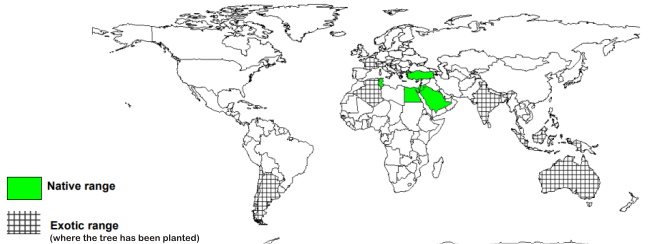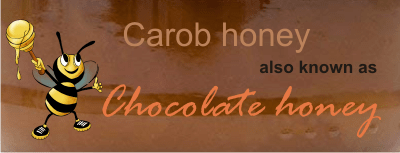Carob powder is known as the substitute of cocoa. But while there is no “cocoa honey” made by bees (though there is a product called “cocoa honey” used for the liquid portion of cocoa pulp that is released from the fruit soon after it is cut open and can be used before fermentation by simple extraction due to its nutritional characteristics.), there is carob honey, an exquisite monofloral honey.
Also known as “chocolate honey”.
Scientific name: Ceratonia siliqua
Other names: carob (from Arabic خَرُّوبٌ (kharrūb) and Hebrew חרוב (haruv)) tree, St John’s bread, locust bean, locust-tree.
* it is often called the poor man’s bread and regarded as a symbol of humility.
* it is known as St John’s Bread (Mark 1:6)The legend says that John the Baptist sustained himself on the Carob beans while travelling in the wilderness. But this was misunderstood, due to name’s similarity. John the Baptist was in fact reported to survive during his time in the dessert eating locusts (insects). This reference has been confused with Locust Bean which is another word for carob.
* Egyptians called this particular tree the Egyptian Fig. The Egyptians not only ate the pods raw but used the gum out of the seeds (LBG) to produce a liquid which they widely used in the mummification of their dead.
* The carat, a unit of mass for gemstones, and a measurement of purity for gold, takes its name from the Greek word for a carob seed, keration, via the Arabic word, qīrāṭ. In late Roman times, the pure gold coin known as the “solidus” weighed 24 carat seeds (about 4.5 grams). As a result, the carat also became a measure of purity for gold. 5 carob seeds equals one gram. A caret weight is 200 milligrams.
Distribution: native to the Mediterranean region, including Southern Europe, Northern Africa, the larger Mediterranean islands, the Levant and Middle-East of Western Asia into Iran; and the Canary Islands and Macaronesia.

Main characteristics:
The carob tree is a flowering evergreen tree or shrub in the pea family, Fabaceae. It grows well in warm temperature and subtropical areas, tolerates hot and humid coastal areas and can reach up to 15 m (49 ft) tall. The crown is broad and semispherical, supported by a thick trunk with rough brown bark and sturdy branches.
The leaves are 10 to 20 cm long (3.9 to 7.9 in), alternate, pinnate, and may or may not have a terminal leaflet. Leaflets are 3-7 cm long, ovate to elliptic, 4-10 normally opposite pairs, coriaceous, dark green and shiny above, pale green beneath finely veined with margins slightly ondulate, tiny stipules.
Flowers: Most carob trees are males and females (dioecious), only some are hermaphroditic, so strictly male trees do not produce fruit. The trees blossom in autumn and the flowers are green-tinted red, small, numerous, 6-12 mm long, spirally arranged along the inflorescence axis in catkin-like racemes borne on spurs from old wood and even on the trunk.
The flowers are unisexual. Females consist of a pistil (6-8.5 mm) on a disk and rudimentary stamens, 5 hairy sepals. Males consist of a nectarial disk, 5 stamens with delicate filaments hairy sepals. In the centre of the disk there is a rudimentary pistil. Hermaphrodite flowers a combination; containing a pistil and a complement of 5 stamens.
The particularities of male flowers and hermaphroditic flowers are that they smell like human semen, an odor that is caused in part by amines, that attracts insects.

Pollination: The trees are pollinated by wind and insects. It is important to use different types of male or hermaphroditic pollinators to overlap with female cultivar bloom, as main cultivars often display a long blooming season of 3-4 months. Since male trees have a shorter flowering period than hermaphrodites, the latter usually show better overlapping.
Flowering period: August, September, October, November.
Nectar: Flowers of all 3 types secrete nectar; the volume of nectar and its sugar content are higher in female flowers than in male. Pollen dispersal is by insects, mainly bees, flies, wasps and night-flying moths.
The pods: The Carob tree matures slowly and bares pods in the 5th – 6th year. They are brown, usually straight and 10-20 cm long. The walls of the pod and the partitions in the fruit contain very high concentrations of sugar, more minerals and vitamins, and less carbohydrates and fat than cocoa. The pods are rich in protein and sugar and have often been proclaimed “wholesome for man or beast”.
The pulp is a valuable sweetener (total sugar content 48-56%) and chocolate substitute and the roasted seeds have even been used as a coffee substitute. The pulp contains about 18% cellulose and hemicellulose. Mineral composition consists of potassium, calcium, magnesium, sodium, iron, copper, iron, manganese and zinc.
Powdered pulp is used as a food ingredient and cacao substitute and for preparing dietary products. Carob pulp is high in total sugar content (48-56%), mainly sucrose (32-38%), glucose (5-6%), fructose (5-7%) and maltose. In addition it contains about 18% cellulose and hemicellulose. The mineral composition (in mg per 100g of pulp) is: K=1100, Ca=307, Mg=42, Na=13, Cu=0.23, Fe=104, Mn=0.4, Zn=0.59. The lipids consist of approximately equal proportions of saturated and unsaturated acids. Five amino acids were found in pod extracts (alanine, glycine, leucine, praline, and valine), also tyrosine and phenylalanine.
Highly recommended to children as a substitute for cocoa. The main attribute is that it helps in fixating calcium, as opposed to cocoa, which depletes the body of calcium. It has fewer calories and neither caffeine nor the obromine. Milk with carob make an excellent drink for all kids.
Unlike cocoa, carob can be safely used to make treats for your pets.
How is carob honey

Aka chocolate honey, carob honey is a monofloral honey, made from the nectar found in abundance on the flowers. Some beekeepers say that honey bees also harvest the honeydew found on the pods (the secretions of aphids found on the fruit pods) which is why carob honey shares many of the characteristic of the carob fruit pod which is very rich in minerals and vitamins and a complete food.
Color: Dark amber, almost black
Taste: similar to chocolate
Flavor: warm, malty, with a medium aromatic intensity. It has chocolate andherbal overtones.
Aftertaste: slightly bitter.
Crystallization: fast, into a soft coarse texture.
Carob honey is high in antioxidants, minerals and antibacterial properties.
Makis Bairaktaris, beekeeper from Kranidi, Greece, says that the first analysis of the honey which the bees had produced at the carob trees of the area highlighted “its pharmaceutical properties were proved as it is very rich in calcium. It has the color of honey from chestnut trees and its own unique taste”.
High antioxidant capacity
According to a 2016 study Ceratonia siliqua honeys from Morocco: Physicochemical properties, mineral contents, and antioxidant activities, conducted by Redouan El-Haskoury, here are the main characteristics of carob honey from Morocco:
· pH: 4.17 to 5.05
· electrical conductivity (0.36-1.35 mS/cm),
· water content (17.30-22.80%)
· free acidity (11.0-42.50 meq/kg),
· lactone acidity (4.0-16.50 meq/kg),
· total acidity (16.50-59.50 meq/kg).
· main mineral present is: Potassium (K) ranging from 644.02 mg/kg in honey from Marrakech Region to 1883.15mg/kg in that from Taounate Region
· sodium (Na): was the second most prevalent mineral in honey samples and the concentration varied in the range of 367.52e855.24mg/kg.
· calcium (Ca) from 129.35 mg/kg to 688.43 mg/kg
· magnesium(Mg) from 18.42 mg/kg to 131.21 mg/kg
· trace minerals of Fe, Zn, Cu, and Ni were detected in all honey samples at low concentrations ranging from 0.71 mg/kg to 4.68 mg/kg, 1.41 mg/kg to 4.26 mg/kg, 0.11 mg/kg to 1.82 mg/kg, and 0.02 mg/kg to 0.15 mg/kg,
respectively.
· heavy metals Pb, Cd, and Co were not detected in all carob honey samples, which indicated honey of good quality and purity.
Comparing these results with those made on carob honeys from United Arab Emirates, Portugal and Spain, the values found for K, Na, Ca, and Mg were very similar.
Carob honey from Morocco:
Total phenols content varied from 75.52 mg GAE/100 g to 245.22 mg GAE/100 g
Flavonoids (flavones and flavonols) contents varied from 2.26 mg QE/100 g to 4.79 mg QE/100 g.
Carob honey from Yemen (similar to that from Morocco):
Phenolic content: 75.13-246.21 mg/100 g
Carob honey from Brazil (lower than that from Morocco) 61.16-111.37 mg GAE/100 g,
India (49-98 mg GAE/100 g)
Serbia (27.44-61.42 mg GAE/100 g)
Algeria (15.84-61.63 mg/100 g)
The total antioxidant power of carob honey varied from 35.03 mg AAE/g to 60.94 mg AAE/g. The highest value was obtained in carob honey from Taounate Region, and the lowest value was found in samples from Marrakech Region.
The antioxidant activity of our carob honey samples was higher than that reported in previous studies on Serbian
honey (11.16e48.48 mg/mL for DPPH and 39.06e120.0 mg/mL for FRAP) [7] and Turkish honey (12.56e152.40 mg/mL for DPPH) [39], but its lowest was when compared to ascorbic acid as a standard compound (8.66 ± 0.66 mg/mL for DPPH and 2.12 ± 0.06 mg/mL for FRAP).
The carob honey from Taounate Region presented the highest antioxidant capacity.
According to Stefan Bogdanov, 2017, carob honey is on the 9th place on the highest antioxidant honeys in the world. Here is the top10:
1. Buckwheat (Fagopyrum sp.)
2. Chinese milk vetch (Astragalus adsurgens)
3. Heather (Caluna vulgaris, Erica umbellata)
4. Honeydew (all types of honeydew honeys)
5. Manuka (Leptospermum Scoparium
6. Strawberry tree (Arbutus menziesii)
7. Sweet chestnut (Castanea sativa)
8. Tualang (Koompassia excelsa)
9. Carob (Ceratonia)
10. Peppermint
The study from 2016, Protective Effect of Morocco Carob Honey Against Lead-Induced Anemia and Hepato-Renal Toxicity, conducted by Fihri AF, evaluated the protective effect against toxic materials, especially against lead-induced hepato-renal toxicity and lead-induced anemia in rabbits.
The results showed that after the oral administration of lead induced hepatic and kidney injury that caused anemia during three weeks of exposure, the treatment with honey prevented hepato-renal lead toxicity and ameliorated lead-induced anemia when honey was given to animals during lead exposure.
Folk health benefits of carob honey
Carob honey is recommended for the regulation of intestinal function for people suffering from constipation or frequent diarrhea (antiseptic properties) but also effective in case of bronchitis, colds, angina.
It also has a positive impact against diabetes and obesity problems.
It lowers cholesterol level in the blood.
Where can we find carob honey?
In any of these countries: Algeria, Cyprus, Greece, Israel, Libya, Morocco, Southern Anatolia, Spain, Syria, Tunisia. Carob is Cyprus black gold and the island was one of carob’s main trading places. Here is some: cyprusflavours.com As they say “The best quality of traditionally made carob honey made in Anogira a village in Limassol.”
We can also find here: wildabouthoney.co.uk
Or, on Amazon.co.uk.
**********
**********
References:
Orwa C, Mutua A , Kindt R , Jamnadass R, Simons A. 2009. Agroforestree Database:a tree reference and selection guide version 4.0 (http://www.worldagroforestry.org/af/treedb/)
Ceratonia siliqua, Turkey, picture credit Nevit Dilmen via wikimedia commons;
Carob tree from Italy, credit Giancarlo Dessì via wikimedia commons;
http://www.scielo.br/scielo.php?script=sci_arttext&pid=S0101-20612014000400016
https://en.wikipedia.org/wiki/Ceratonia_siliqua
Further reading: https://www.sigmaaldrich.com/life-science/nutrition-research/learning-center/plant-profiler/ceratonia-siliqua.html

